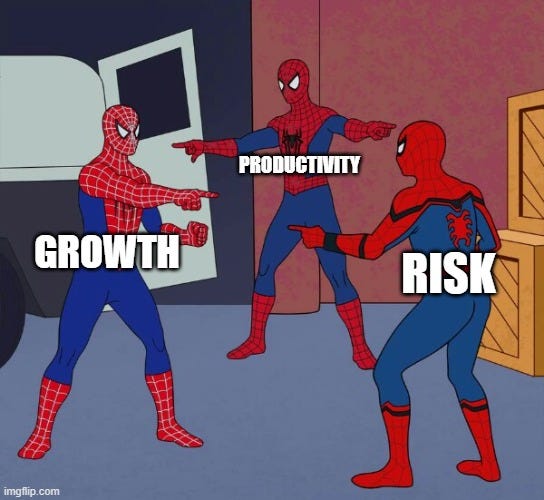A shorter piece this week. I suffer from an overthinking mind. In some contexts this is a good thing, but when it comes to writing snappy articles, not so much. So, in the spirit of JFDI, here is a little piece about data and value. Something I think about a lot (yes, I need to get out more).
Beyond the buzz
Creating value is the whole point of data. It’s why we collect, manage, and analyse it in the first place.
That should go without saying, but I find myself repeating it constantly. Too often, data professionals get caught up in tools, code, and frameworks, losing sight of the one thing that really matters: value.
Ask any seasoned data leader, and they’ll tell you this is a real problem.
Data is still too often seen as a cost of doing business, not a reason to do business.
Yet value is the one thing nearly every data leader agrees they want to create.
Whether they succeed is another question. The Chief Data Officer role is infamous for its short shelf life, and not without reason.
The data leaders who thrive are those who understand their job is to create and demonstrate value. That’s how they earn trust, investment, and a seat at the leadership table.
From data strategies to AI initiatives, and data literacy to data products, value is the common thread. But like many buzzwords in data, it’s often used without clarity.
So let’s unpack what it really means and why it matters.
What is data value?
Value is the benefit or utility you get from something. In data, it’s about how useful, meaningful, or profitable the data is when it informs decisions and actions.
Data’s value stems from its use, so the more valuable the use (relatively speaking), the more valuable the data.
But data value is also contextual.
A grocery store may get immense value from customer data on milk and egg purchases. For a luxury handbag brand? Useless, unless someone finds a weird link between egg buyers and designer bags.
The point is that the value of data depends entirely on your business model. The more your decisions rely on a type of data, the more valuable that data becomes.
Measuring value
If value is the goal, then we need ways to measure it. This is a huge subject in itself, so I’ll just touch on it here. I won’t reveal much about how this is done, as there is a lot to say and some of it is secret sauce!
Financial measures of data value are always the most compelling to leadership. They include metrics like cost savings from process improvements, incremental revenue from data-informed marketing campaigns, or perhaps reduced losses through better risk management. Financial value can be ascribed at different levels, such as data use cases and even the datasets themselves, based on their estimated role in decision making activities that lead to commercial gain.
Not all value is financial, at least not directly. Data can also support strategic goals that are harder to quantify, such as improving customer experience, supporting sustainability, or building institutional knowledge. These outcomes can be measured through proxies (sometimes financial ones) like NPS uplift, reduction in customer complaints, carbon savings, or improved employee satisfaction.
While measurement of impact is the route to valuing data, and treating it as an asset, not everything can be easily measured. It is vital to measure critical outcomes from data, but trying to measure everything tends to dilute the importance of our most important indicators. Some datasets or insights create foundational capabilities that pay off later, or in ways we can’t isolate. Some forms of value, like data trust, culture, or literacy, are slow-burn and diffuse. That doesn’t mean they’re not critical. But it does mean we need to accept a degree of ambiguity when managing for value, and avoid the trap of only prioritising what can be neatly quantified.
The Data Value Triad
We can think of data value in three broad buckets:
Growth: driving revenue, customer acquisition, market share.
Productivity: doing more with less, boosting efficiency.
Risk: managing compliance, avoiding failure, protecting assets.
Balancing these is the core challenge of managing data for value. The mix will vary based on your sector, strategy, and moment in time.
Our egg based retailer might use data to grow via personalised offers, improve productivity via inventory management, and manage risk through food safety and fraud detection.
Every organisation needs to consider all three, and usually at the same time, but the emphasis shifts based on business needs.
The tension
These value streams often pull in different directions, which can cause a number of headaches for those managing data.
Conflicting Demands
Sales wants faster insights. Ops wants cost-saving automation. Compliance wants tighter controls.Competing Timelines
Growth needs speed. Productivity needs iteration. Risk needs guarantees.Shadow Data and Tool Sprawl
Teams chasing growth build their own stacks, creating mess, inconsistency, and risk.Pressure to “Do It All”
Data leaders are expected to drive growth, enable AI, cut costs, and stay compliant (everything, everywhere, all at once - to borrow a phrase).
Achieving balance
So how do you navigate this? Here are six quickfire lessons from my own experience:
1. Start with strategy, not tech
Don’t lead with platforms or tools. Lead with business goals.
Ask:
What are we trying to grow?
Where are we inefficient?
What could hurt us?
Many data projects fail because they jump straight to technical solutions without a clear ‘why.’
2. Balance the Triad by business need, not symmetry
You don’t need to invest equally across growth, productivity, and risk.
A startup may lean heavily on growth.
A manufacturer may focus on productivity.
A bank may prioritise risk.
All three need baseline attention, but your focus should match your business context.
Trying to treat everything as a priority means nothing is.
3. Measure outcomes, not outputs
It’s easy to track activity, often in terms of, dashboards built, pipelines run, data ingested.
But outputs aren’t outcomes.
Value comes from impact:
What decision did this data improve?
What did it save or earn?
What risk did we avoid?
That’s what stakeholders care about.
4. Break down silos
Growth lives in marketing. Productivity in ops. Risk in compliance.
If your data team sits apart, value stays theoretical.
Embed data people in teams that own outcomes - not just report on them.
5. Invest in agility, not perfection
Priorities shift. One quarter it’s expansion, the next it’s compliance.
Build flexible systems:
Light governance that doesn’t stall progress
Data products that evolve with business needs
Teams that can pivot quickly
6. Build data literacy around value
Everyone doesn’t need to become a data expert. But they do need to understand how data creates value in their daily lives.
The more fluently your people can talk about data’s impact, the easier it is to align around it.
Final Thought
Managing the Data Value Triad is about alignment, agility, and impact.
The best organisations track outcomes across growth, productivity, and risk, and treat data as a means to an end, not the end itself.
Because in the end, value isn’t in the data. It’s in what you do with it.




Great article, James!
I always advocate for having a product owner for data initiatives (even just internal ones). At the end of the day, in agile teams, product owners are the ones in charge of maximizing value from one iteration to the next, but many organizations rely on technical analysts and specialists to deliver these solutions without a "Data translator" that can help maximize value from it.
I feel like maximizing value is a hard thing to do for a technical person who's under pressure to deliver the next request. The product owner could speak the language of business a bit more easily and strategize on how to deliver value from data initiatives while translating it back to the technical team.
A useful extension of the 2017 HBR piece “What’s your data strategy?” which focused on two dimensions, i.e., “offensive” (growth) and “defensive” (risk/compliance)